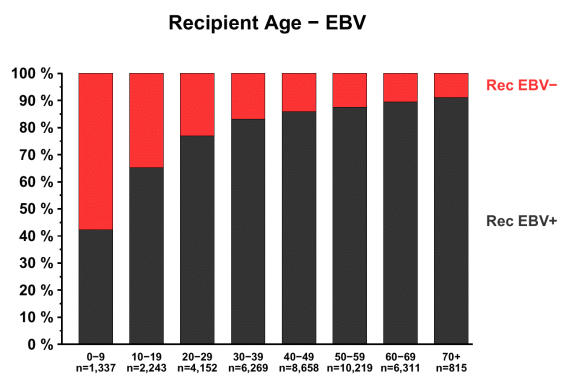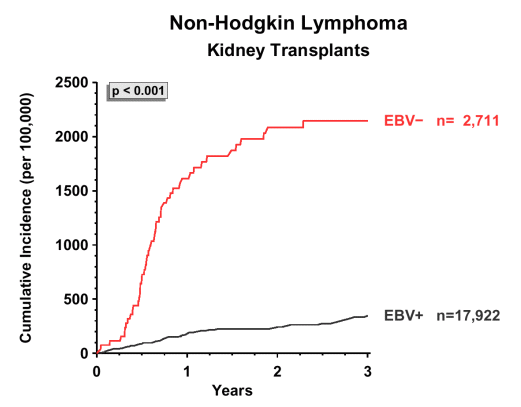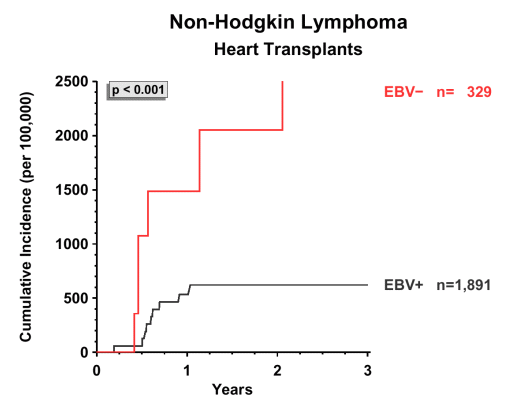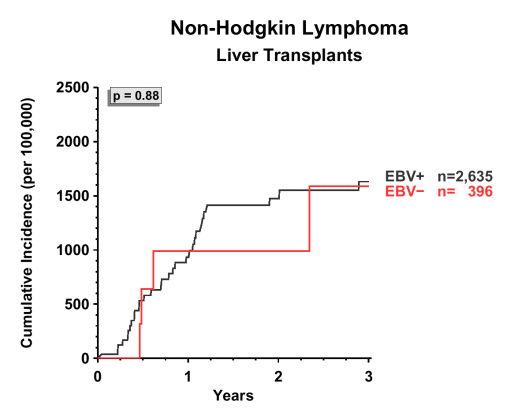
Figure 1
November 1, 2009
Non-Hodgkin lymphoma (NHL) is a feared complication of immunosuppression, associated with a high mortality rate. We have previously provided several reports on NHL based on the CTS experience. Some 90% of NHL are B-cell lymphomas, and primary infection with Epstein-Barr virus has been identified as the main cause of NHL. Viral infection in the presence of immunosuppressive drugs promotes the proliferation of B-lymphocytes, which leads to uninhibited B-cell growth due to the suppression of T-cell control.
In several studies, negative pre-transplant EBV serostatus has been identified as a risk factor for the development of post-transplant NHL. Robust epidemiological data on the EBV status of patients prior to transplantation, however, remained scarce. In 2003 we initiated the recording of pre-transplant EBV status in the CTS. With your help, data on more than 40,000 patients awaiting a kidney, heart or liver transplant have now been obtained. Figure 1 shows the relationship of EBV serostatus with patient age. As expected, children have a much higher EBV-negative rate than adults and EBV-positivity increases progressively with age.

Figure 1
Figure 2 illustrates the analysis of pre-transplant EBV serostatus in relation to the development of post-transplant NHL in kidney transplant recipients. The pronounced early increase in the occurrence of NHL among EBV-negative patients is an indication that EBV primary infection is indeed responsible for NHL development.

Figure 2
Data in heart transplantation are based on smaller patient numbers but essentially confirm the important role of negative pre-transplant EBV serostatus in relation to development of post-transplant NHL (Figure 3).

Figure 3
Surprising - and quite unexpected - results were obtained in liver transplant recipients. Whereas the incidence of NHL in EBV-negative liver recipients was relatively similar to that seen in EBV-negative kidney recipients, the results observed in EBV-positive liver and kidney patients were dramatically different. EBV-positive liver recipients showed a far higher incidence of NHL than EBV-positive kidney recipients and there was no appreciable difference between the rate of NHL in EBV-negative or -positive liver transplant patients. It therefore appears that negative pre-transplant EBV serostatus is not a useful indicator of NHL risk in liver transplant patients. The key finding in liver recipients is the high rate of NHL in EBV-positive individuals, a result that is unlikely to be an error due to the large number of patients (n=2,635) examined. Why EBV-positive liver patients develop NHL at such a high rate is currently unknown. Conceivably, other viral infections that trigger lymphomapromoting cytokine release may play a role.

Figure 4
These results are another demonstration of the outstanding value of the CTS. Without your active support for this multicenter collaborative project, the important differences described in this newsletter would probably have remained undetected for many more years. More research is needed to elucidate the underlying mechanism. Each one of you who contributed data on EBV serostatus and post-transplant NHL deserves to be given credit!
Thank you for your continued support of the CTS.
With best wishes,